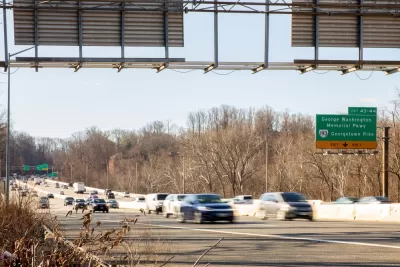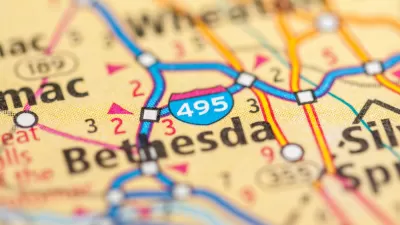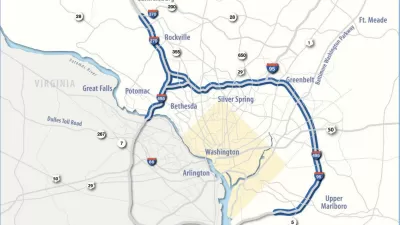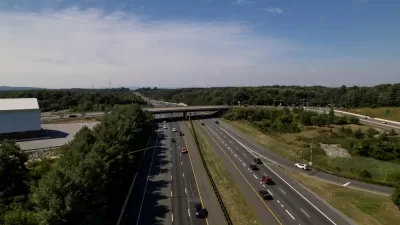In a victory for Governor Larry Hogan, who has championed the project, the Federal Highway Administration is allowing the Beltway expansion project to move ahead.

Maryland Governor Larry Hogan’s controversial $5 billion plan to expand parts of the Beltway and Interstate 270 can move forward after the Federal Highway Administration signed off on the project, reports Ian Duncan in the Washington Post. “Maryland is planning to add two toll lanes to the Beltway in each direction, between the Virginia side of a new and expanded American Legion Bridge and the exit for Old Georgetown Road in Bethesda,” and convert two I-270 lanes to toll lanes. The plan was scaled back in May 2021 in response to strong opposition from some officials and environmental groups.
The project also includes some funding for transit. “The contracting group with which the state intends to partner would provide $300 million for transit in Montgomery County over the life of the project. The state transportation department would build a new facility and provide a fleet of buses, and allocate a further $60 million to design transit projects in the county.”
Nevertheless, transit advocates criticize the project, saying the approval process lacked transparency and “ignored valid concerns from members of the public, and advocates from the environmental and transportation communities.” According to a separate article in Maryland Matters by Danielle E. Gaines, transit advocate Ben Ross cited “possible scientific fraud,” saying that “he found unexplained changes in the traffic models the state used to determine how much time motorists would save by using toll lanes.” The Federal Highway Administration stated they failed to find evidence of any fraud. The project now requires approval of the contract by the state’s Board of Public Works.
FULL STORY: Controversial Hogan plan for Beltway, I-270 toll lanes gets green light

Alabama: Trump Terminates Settlements for Black Communities Harmed By Raw Sewage
Trump deemed the landmark civil rights agreement “illegal DEI and environmental justice policy.”

Study: Maui’s Plan to Convert Vacation Rentals to Long-Term Housing Could Cause Nearly $1 Billion Economic Loss
The plan would reduce visitor accommodation by 25% resulting in 1,900 jobs lost.

Why Should We Subsidize Public Transportation?
Many public transit agencies face financial stress due to rising costs, declining fare revenue, and declining subsidies. Transit advocates must provide a strong business case for increasing public transit funding.

Paris Bike Boom Leads to Steep Drop in Air Pollution
The French city’s air quality has improved dramatically in the past 20 years, coinciding with a growth in cycling.

Why Housing Costs More to Build in California Than in Texas
Hard costs like labor and materials combined with ‘soft’ costs such as permitting make building in the San Francisco Bay Area almost three times as costly as in Texas cities.

San Diego County Sees a Rise in Urban Coyotes
San Diego County experiences a rise in urban coyotes, as sightings become prevalent throughout its urban neighbourhoods and surrounding areas.
Urban Design for Planners 1: Software Tools
This six-course series explores essential urban design concepts using open source software and equips planners with the tools they need to participate fully in the urban design process.
Planning for Universal Design
Learn the tools for implementing Universal Design in planning regulations.
Smith Gee Studio
Alamo Area Metropolitan Planning Organization
City of Santa Clarita
Institute for Housing and Urban Development Studies (IHS)
City of Grandview
Harvard GSD Executive Education
Toledo-Lucas County Plan Commissions
Salt Lake City
NYU Wagner Graduate School of Public Service





























